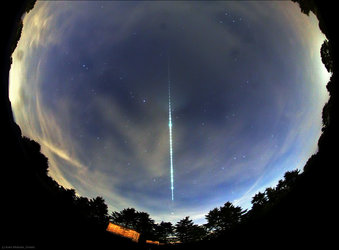The world watched when Leonardo De Caprio’s Don’t Look Up hit Netflix, warning us of the imminent dangers of asteroids and our slow response to countering them. A similar scenario unfolded last week when astronauts detected an asteroid with a low chance of hitting Earth, crashing to the surface.
Yes, an asteroid hit Earth and we knew about it in advance, barely two hours before impact. The only good thing was that this extraterrestrial object was 2 meters in size, limiting its damage to a minimum. Had it been bigger and probably a kilometer-long in width, the consequences could have been dangerous.
Asteroid 2022 EB5 was too small to pose a hazard to Earth and it’s only the fifth time that humans were able to detect an asteroid before it hit the planet, which already has over 200 craters from outer space strikes spanned over millions of years in the past. The March 11 strike was predicted by astronomers, who knew it was on a collision course, predicting exactly where and when the impact would happen.
HOW WAS THE ASTEROID DISCOVERED?
Astronomer Krisztián Sárneczky discovered a bright and fast-moving new object in the sky using the 60cm Schmidt telescope at the Piszkéstet observatory, Hungary. After conducting four observations of the unknown object, he reported his findings to the Minor Planet Center (MPC), within 14 minutes. At the time, the impact assessment showed a less than one per cent chance of impact.
Krisztián conducted 10 more observations and the scenario changed drastically. The asteroid was headed straight for Earth. Almost exactly an hour after it was detected, ESA’s “Meerkat” monitoring system triggered an alert to the Agency’s Near-Earth Object Coordination Centre (NEOCC). Meanwhile, an alert was sent to the Center for Near-Earth Object Studies (CNEOS) and NASA’s Planetary Defense Coordination Office.
Nasa’s Scout impact hazard assessment system determined that 2022 EB5 will enter the atmosphere southwest of Jan Mayen, a Norwegian island 470 kilometers off the east coast of Greenland and northeast of Iceland. The impact was confirmed by infrasound detectors.
WHAT IF IT WAS A LARGE ASTEROID?
It is estimated that between 40 and 100 tonnes of space material strike Earth every day, most in the form of very small particles. Nasa assured that a larger asteroid with hazardous impact potential would be discovered much farther from Earth. Since 2022 EB5 was too small, these objects get bright enough to be detected only in the last few hours before their impact. They are much smaller than the objects that the Planetary Defense Coordination Office is tasked by NASA with detecting and warning about.
“Tiny asteroids like 2022 EB5 are numerous, and the impact into the atmosphere quite frequently roughly every 10 months or so. But very few of these asteroids have actually been detected in space and observed extensively prior to impact, basically because they are very faint until the last few hours, and a survey telescope has to observe just the right spot of the sky at the right time for one to be detected,” Paul Chodas, the director of CNEOS said.
The European Space Agency said that large asteroids, kilometers in diameter, are easier to spot. Although they could do immense damage, they are relatively rare. All five asteroids, spotted before impact, were found since 2008.
With space agencies preparing missions to deflect large asteroids during their course, observation of this new asteroid before impact is set to enhance the understanding and tracking systems for Near-Earth Objects.







Leave a Reply